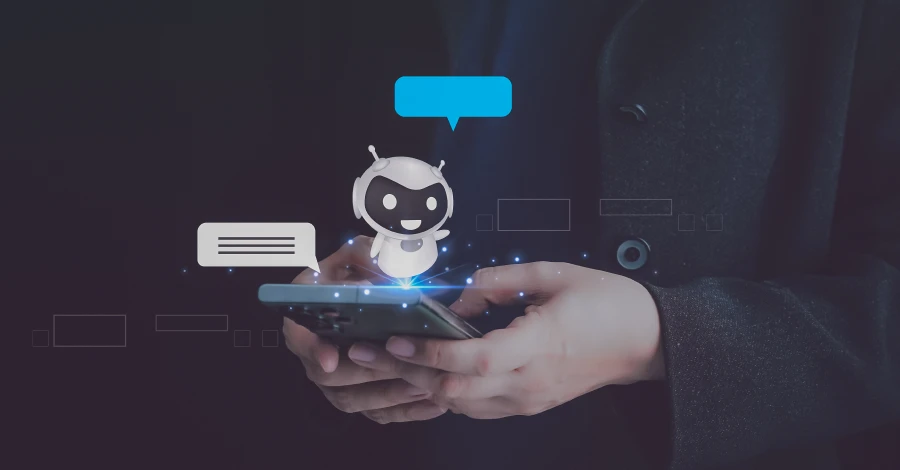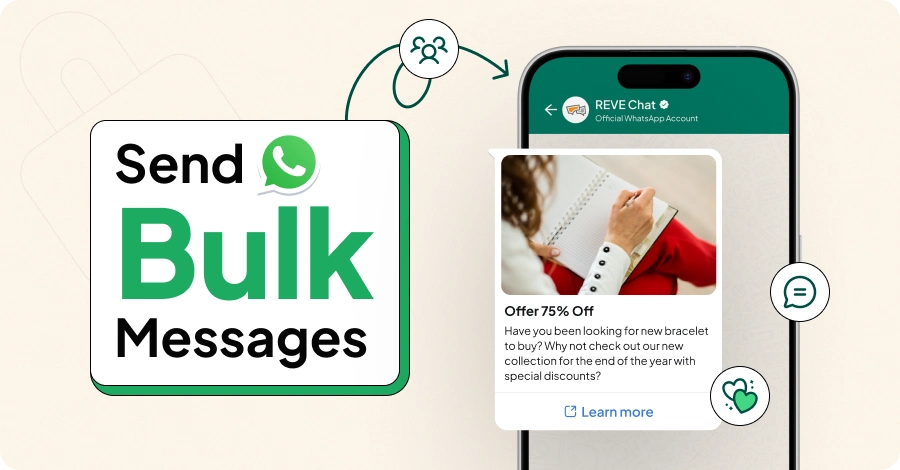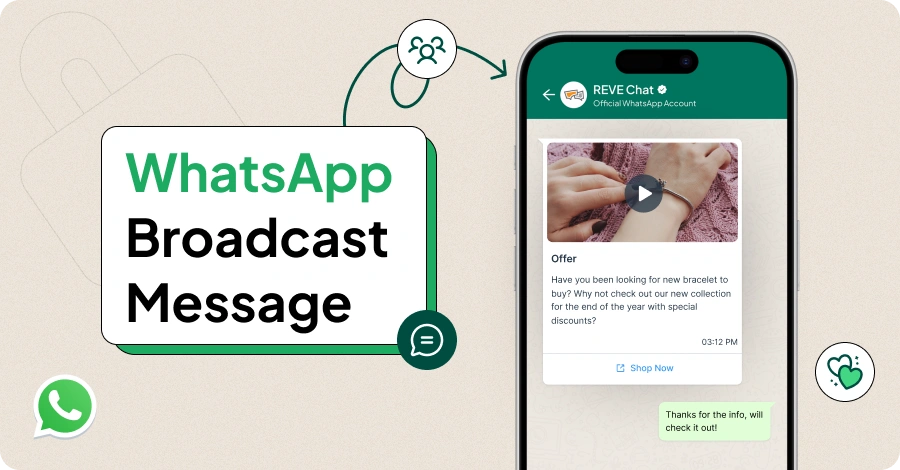Building an Ecommerce Sales Funnel: Stages, Optimization & Examples
- February 6, 2024
- 19 mins read
- Listen

Running an online store is a challenging endeavor. The competition is stiff as customers have so many different options to choose from. The biggest challenge lies in getting people to visit the store and buy.
And if you think people will buy because your ecommerce store exists, you’re mistaken.
Sales won’t happen unless you:
- Know your target audience
- Understand the needs and expectations of your potential customers
- Make them aware of the products
- Give them offers not available elsewhere
- Map out the buyer’s journey
- Learn what makes them convert or abandon their carts
A well-planned ecommerce sales funnel will help you achieve all this.
But how?
In this blog, we will explore the conversion funnel in detail, and understand its definition, various stages, importance, optimization, and examples.
Before moving further, let’s first get started with understanding what an ecommerce sales funnel is…
What is an Ecommerce Sales Funnel?
In marketing, a sales funnel is a visual concept that displays the various stages of the customer journey. It’s also a digital representation of your customer’s buyer journey as every individual customer has a unique journey and goes through various stages and makes various decisions.
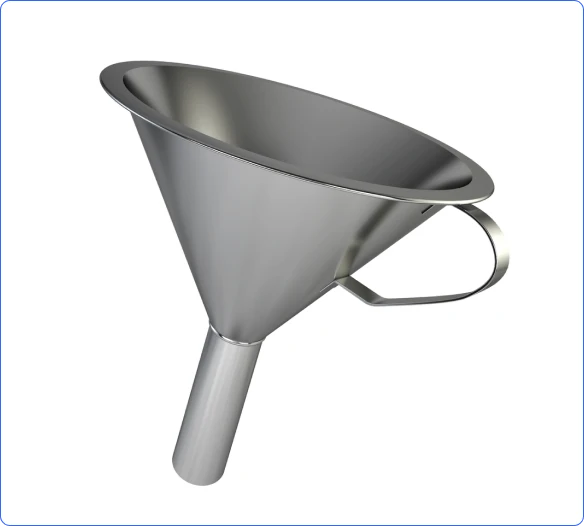
When the customers first visit your website, they are on top of the funnel and you will try to push them through different stages. This is done to guide them to the bottom, which ultimately materializes into conversion.
This funnel is useful for understanding specific touchpoints, how customers interact at each stage, and the marketing strategies required to convert them.
Do You Need a Sales Funnel for Your Online Store?
Yes, you need a sales funnel!
You need it not because the average sales funnel conversion rate ranges from 3% to 7%, but because it offers so many great benefits for your business!
A well-structured sales funnel can help you guide potential customers through a series of steps that build trust and lead to a purchase. The funnel will help you gain insights into customer needs, interests, and behavior – and the data you collect will help you identify areas of improvement. Based on that, you can refine your marketing strategies and engage better with your customers at various touchpoints, making them more interested in your products or services.
In addition, the conversion funnel is vital to addressing customer issues at each stage and providing the right information at the right time. It will help you identify the best channels and strategies for each stage and make you understand how potential customers go through the funnel.
Similarly, using a sales funnel can guide you in allocating marketing resources judiciously for each stage and optimizing your return on investment (ROI). It can help address users’ concerns before the final stage and reduce cart abandonment rates.
In essence, you can ensure a smoother and more enjoyable experience for customers by helping them move through a well-optimized funnel.
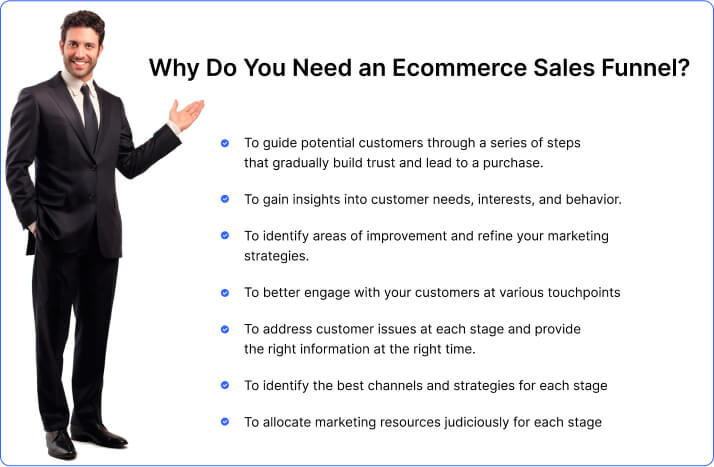
Four Stages of the Ecommerce Sales Funnel
An ecommerce sales funnel typically has four stages. However, there is no universally acceptable number of stages for a funnel. It entirely depends on the number of steps a business needs to convert prospects into customers.
1. Awareness Stage
This is the top of the funnel. People in this stage are aware of their problems and they’re also aware of your brand. In this stage, potential customers make first contact with your business, or vice versa.
People in this stage search for solutions and find you as a possible option. They may find you by chance, through search, social media, or referrals.
In this stage, you aim to make more and more people aware of your business. You need to take steps so that as many as possible people can get interested in your offers.
Key strategies you can use for the awareness stage include:
- Use social media paid ads, pages, and profiles to grow brand awareness
- Create high-quality content such as blog posts, articles, how-to-guide posts, etc to share information about your products
- Use paid ads on different channels like Google and Facebook for a more targetted outreach
2. Consideration Stage
By the time your audience reaches the consideration stage, they already know you exist.
All your strategies in the awareness have worked well in guiding potential customers to this stage. As the name suggests, this stage is where your audience starts considering your product as a potential solution to their problem.
In this stage, you need to convince the prospects that you’re the answer to their problems. You need to present yourself as the solution they’re looking for. This is why your marketing strategy needs to be subtle and compelling to convince them the same.
Consumers in the consideration stage may also decide to subscribe to your newsletter or the RSS feed on your blog. Chances are very high that they might also show interest in a paid content upgrade.
Key strategies for the consideration stage –
- Use social proof and showcase Google reviews, social comments, testimonials
- Fill each of your product pages with as many positive social proofs as you can
- Consider optimizing your product pages as they drive conversions
- Make sure each product has good-quality images, videos, and clear descriptions
- Promote your products through email marketing
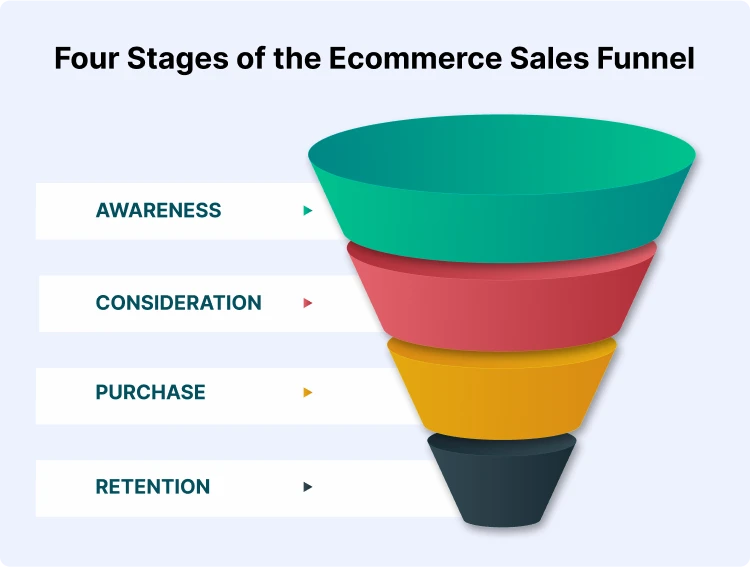
3. Purchase Stage
Consumers in this stage want to buy. They are ready to purchase a product to fix their problem. Your offer is one of the considerations for them, but they are not sure about your product. Maybe, you need to convince them a bit more.
In this stage, you have two major responsibilities –
- Make the purchase decision as easy as it can be for potential buyers
- Present yourself as the most viable option for their problem
Needless to say, the purchase stage is all about showing how you’re the best bet in the market for consumers. It’s the stage to show how you’re a better option in many ways – be it the products, prices, payment choices, shipping options, etc.
Key strategies for the purchase stage –
- Evaluate your checkout process and remove any friction that might negatively impact the conversion rate
- Ensure that your checkout process is neither complex nor too long, and also focus on removing surprises that come in the form of hidden fees or other expenses with shipping, etc
- Provide buyers with a variety of payment options as this expands choices and encourages buyers to commit
- Avoid bothering customers with too many needless details and only ask for essential information
- Send personalized emails based on audience behavior
- Make your checkout page as user-friendly as possible
- Send cart abandonment reminders
- Add compelling CTAs, discounts, and free shipping
4. Retention Stage
The retention stage is the bottom of your ecommerce sales funnel. By this stage, you have turned your audience into paying customers. Now your priority is to convert them into loyal customers. You should look for repeat purchases because a sales funnel doesn’t end with the first purchase itself.
This stage is important because it allows you to get customers back to your store after making a purchase. You should leverage this opportunity because acquiring a new customer can cost you five to 25 times more than retaining an existing one, says Harvard Business Reviews.
Key strategies for the retention stage –
- Consider using loyalty programs to reward return customers
- Use email marketing for engagement, and also for saying thank you for the purchase
- Run points-based loyalty programs
- Send personalized emails to existing customers with offers of upsells, cross-sells, and add-ons
Useful Ecommerce Funnel Metrics to Track
It’s important to track and analyze key funnel metrics. It can give valuable insights into the sales funnel’s performance. The more you track, the better you can be prepared to plug in holes in the customer journey. Here are some key KPIs and metrics you should be monitoring –
Traffic Source
When you run an online store, you should know the best sources of traffic for your website. Whether it’s paid ads, organic searches, social media, or referrals, you need to analyze the various channels sending visitors to your store. This insight is key to focusing on the most productive channels and optimizing the marketing efforts accordingly.
Conversion Rate
The conversion rate is another vital metric you should track to measure the performance of your sales funnel. A high conversion rate suggests that your ecommerce sales funnel is efficient and is effectively guiding potential customers through the funnel stages. It measures the percentage of website visitors who take the desired action, such as signing up for a newsletter, showing intent to purchase, or making a purchase.
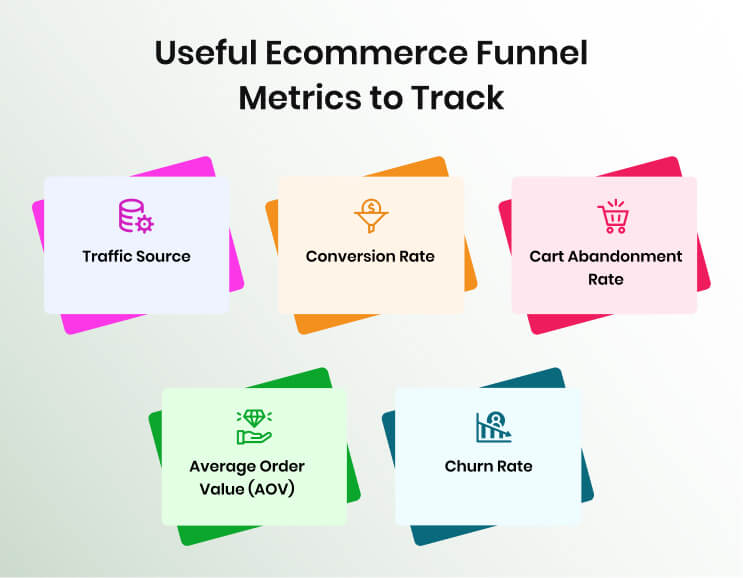
Cart Abandonment Rate
Many visitors to ecommerce websites just add items to their shopping cart but don’t move beyond that. They show intent but don’t complete the purchase. The cart abandonment rate is a metric that will help you understand the friction points or barriers in the checkout process. You can take steps to fix those issues and reduce the cart abandonment rate.
Average Order Value (AOV)
Increasing the average order value is often the goal for online stores as it leads to higher revenue and profit. That’s why AOV is a key metric to track as it gives information about the average amount spent by customers in a single transaction. Your business can implement various strategies to boost average order value, such as running promotions, offering product bundles, upselling or cross-selling, etc.
Churn Rate
The churn rate is a key metric to monitor and track as it gives insights into customers who stop engaging with your business over a specific period. Tracking this metric can help you understand customer retention and loyalty. A high churn rate is never helpful for an ecommerce business as it suggests the need to retain more customers through improved support.
How to Create an Ecommerce Conversion Funnel?
Step 1: Establish a Buyer Persona
Establishing a buyer persona is the first step in building an e-commerce conversion funnel. This will help you create a fictional representation of your ideal customer whom you could target.
To create a buyer persona, you need basic information about your target customer, such as demographics and psychographics.
You need to know where your ideal customer lives, age, gender, job title, income, preferred social channels, and most importantly, their pain points.
The above information will be key in creating a detailed buyer persona for your funnel.
Step 2: Define the Conversion Funnel
Once you have established your buyer persona, it shows you know who to target. The next step is to define the funnel.
Defining the conversion funnel means creating a list of different steps in your sales process that help customers move from the awareness stage to the purchase stage. It also means creating a path that helps potential customers move through the sales process with you.
For example, if you’re a SaaS company, you can define the sales funnel as follows:
- Potential customers click an ad or ( click a link in a blog post ) and reach a sales page or landing page.
- They enter basic details such as name, email, etc to send requests for product demos, and quotes from you.
- Customers receive a response from you and then decide whether to purchase from you.
- Customers buy from you.
- They refer your brand to others.
Step 3: Optimize Your Website’s Landing Pages
A well-defined conversion funnel will help drive visitors to your website’s landing pages. It’s therefore important to optimize those pages for conversions.
The main purpose of optimizing the landing pages is to keep them clear and concise so that visitors don’t face problems in taking specific actions.
Sales and conversion rates shoot up when landing pages are easy to navigate for visitors and are free of needless distractions.
To optimize your e-commerce landing pages, make sure –
- Your landing page has a prominently visible, strategically placed, and easily readable CTA ( call to action ) button.
- Your sales pages have proof of trust like reviews and testimonials
- There are detailed product descriptions to quickly sum up the main features and benefits to customers

Step 4: Grow Your Email List
Optimizing the landing pages of your website will help you win email subscribers. Using blog posts to share information is another way to win people interested in your email subscription.
Creating a lead magnet is one of the best ways to get website visitors to share their email addresses with you. A lead magnet is a valuable piece of content you offer in exchange for emails. This is how you grow your email list.
Tips to create a lead magnet –
- Write a blog post or article about your business
- Make the content value-addition for your potential leads
- Focus on discussing things in the content that enrich visitors and build their interest in your product or service
5. Get Traffic to Your Website
Without a steady flow of traffic, your ecommerce business won’t grow, let alone flourish. But yes, traffic will start rolling when you have fully optimized your website and built your email list. You can also be proactive and take certain steps to get the traffic going for your website.
Key strategies to get visitors to your website-
- Rely on organic methods to drive traffic by using blogging. Write blogs and articles targeting keywords and phrases your target audience may be interested in.
- If budget is not a concern, you can invest in paid ads on Google and Facebook to drive traffic quickly to your website.
- Leverage social platforms like Twitter and Facebook to promote your new content, encourage people to share your post, do likes and comments
- Send emails to your list of subscribers and inform them about new product launches, new features, discounts, etc.
- Collaborate with influencers and cash in on their huge followers
6. Use Retargeting Ads
Not all visitors to your website will convert. Some of them – or most of them – might bounce out for one reason or another. They may leave without purchasing from you. Since they have visited your site and shown some interest, you should retarget them to boost the chances of conversion. Retargeting can help you reach them and hopefully re-ignite their interest in your product or service.
The right approach is to create an email marketing campaign and target people who visited your site but left without making a purchase. You can also send relevant ads based on the specific pages visited by people.
Step 7: Measure the Results
Tracking and measuring the results of your ecommerce conversion funnel is key to understanding its overall performance. Unless you measure the results, how can you know how much effective your sales funnel is?
To measure the results, consider analyzing these aspects:
- Analyze data of your website visits and check which specific parts get the most interest from visitors
- Understand how visitors interact with your website and ads
- Consider adjusting your marketing campaigns based on the behavior shown by visitors for your retargeting ads
4 Steps for Successful Ecommerce Sales Funnel Optimization
Step 1: Identify Problem Areas in Your Sales Funnel
Before optimizing your sales funnel, you need to find out the reasons affecting your conversion. You need to identify the areas causing potential customers to lose interest. It’s also important to see why prospects are dropping off and not progressing ahead, or getting through to the next stages in the funnel.
Problems may occur at any stage, from the awareness to the purchase. Maybe CTAs are not clear or maybe the checkout processes are complicated. Conversion also gets affected when buyers don’t get sufficient product information.
So, find out the problems, and take specific action for each of them and this can improve the flow of the funnel.
Step 2: Use Specific Metrics to Track Progress
When you optimize the sales funnel, you should set clear and quantifiable goals to track the progress. If goals are vague and unclear, it might not give a clear picture of what is ailing your conversion chances.
In addition, your goals should be aligned with specific metrics you should be analyzing and tracking. Whether you want to reduce the churn rate or increase the conversion rate, make sure you have a certain percentage point in mind to achieve.
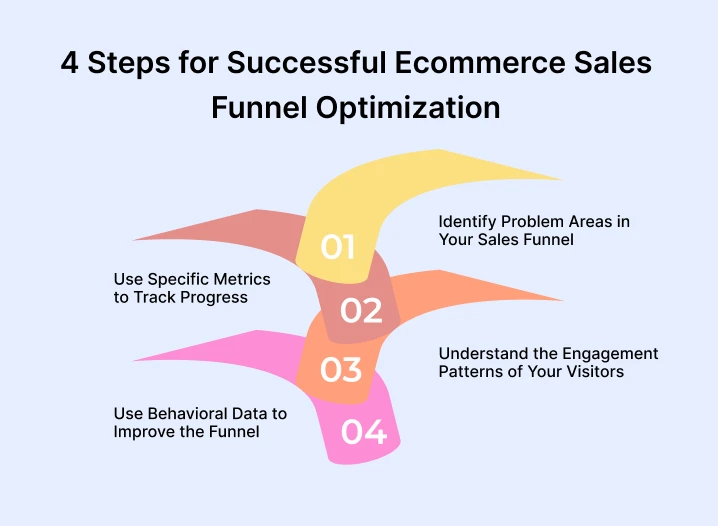
Step 3: Understand the Engagement Patterns of Your Visitors
All your optimization efforts would stand to nothing if you’re not methodical in your approach. The key is to use a data-driven strategy as it can guide your optimization efforts in the right direction.
When we say a data-driven strategy, it means you need to gain detailed insights into your prospects’s needs, preferences, and pain points. This can only happen when you continuously study your visitor’s behaviors throughout the sales funnel.
How your visitors engage with the different forms of content, what touchpoints they show the most interest in, and where they are going off the funnel – analysis of these points can give you a good idea of the engagement patterns of your visitors.
Step 4: Use Behavioral Data to Improve the Funnel
Analyzing how visitors engage with your website and content types will give you detailed information about the problems they face. Based on that, you can identify the areas to work on and then implement targeted changes.
Your focus should be on enhancing the user experience through the various stages of the sales funnel. This can’t happen unless the funnel is frictionless and intuitive. The more compelling your sales funnel is, the more chances of conversion it will create.
Best Practices for Your Ecommerce Sales Funnel
- Remove Barriers to Purchase – Work on removing barriers to purchase. Keep the focus on minimizing hesitation so that buyers feel encouraged to purchase. Offer free shipping to buyers; give free returns; add a chatbot to your website to remove pre-sale doubt; show security badges on your website on as many pages as possible to convince buyers.
- Make it Easy to Buy – Are you offering multiple payment options to buyers? Is your checkout process streamlined? Do you have any hidden shopping costs? Check all this to make it easy to buy.
- Let Visitors Find Things Easily – Customers might feel frustrated and drop off when site navigation is not easy to follow. Make sure the menus are easy to use and your site’s search is optimized. It will help visitors find things easily.
- Provide a Seamless Mobile Experience – Focus on providing a seamless mobile experience to your customers as mobile devices today contribute a large part of e-commerce traffic.
Ecommerce Sales Funnel Examples
Many e-commerce companies understand how to strategically move customers through various stages of the funnel and drive conversions. They have unique strategies that fit well with their industry and audience. Some of the examples are given below –
Amazon
Amazon is the world’s leading ecommerce company that has a robust sales funnel in place to drive users through the stages. In the awareness stage, it relies on digital marketing, ads, and SEO and then builds interest through sponsored ads and email campaigns. More so, Amazon engages users with personalized recommendations and builds consideration through detailed descriptions and reviews. The company then uses discounts and urgency deals to encourage decisions. The smooth checkout process with little friction makes it easy for buyers to complete their purchases.
Zappos
Zappos is a well-known clothing retailer that uses an effective sales funnel for converting potential customers. It uses content marketing, social channels, and influencer collaborations to generate awareness. The company builds interest through detailed customer reviews and descriptions on its website. More importantly, it offers assistance to customers during their decision-making process and supports purchase decisions through a one-year-long return policy. It has removed all the hassles to make the checkout process as simple as it can get and its continued focus on post-purchase engagement contributes to improved conversion.
Final Thoughts
It takes considerable effort to turn an ecommerce business into a success. Traffic and sales go up only when you have devised the right strategies. The most important aspect is to ensure value to customers at each stage of their journey. That’s why you need to create a well-defined ecommerce sales funnel and effortlessly move users through various stages and touchpoints.
At REVE Chat, we realize the huge role of engagement in making an effective conversion funnel. We have tons of engagement tools your business can rely on to interact more with users and make their experiences satisfying.
We have an AI-powered chatbot to automate replies. You can also leverage our live chat software to deliver hybrid support.
With us, you can sign up and check how our tools can add great value to your sales funnel.

